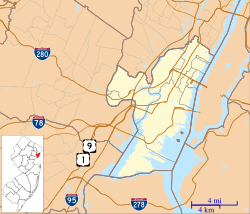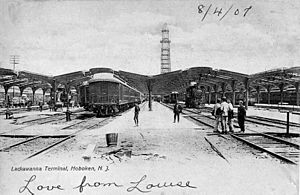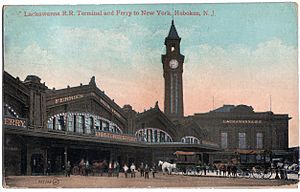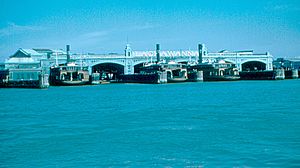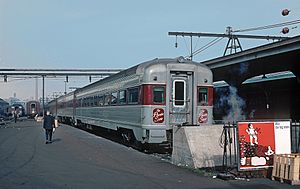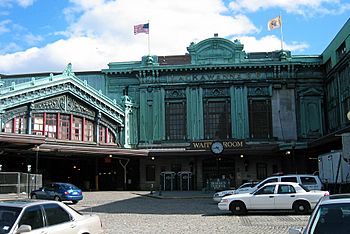Hoboken Terminal facts for kids
Quick facts for kids
Hoboken Terminal
|
|||||||||||||||||||||||||||||||||||||||||||||||||||
|---|---|---|---|---|---|---|---|---|---|---|---|---|---|---|---|---|---|---|---|---|---|---|---|---|---|---|---|---|---|---|---|---|---|---|---|---|---|---|---|---|---|---|---|---|---|---|---|---|---|---|---|
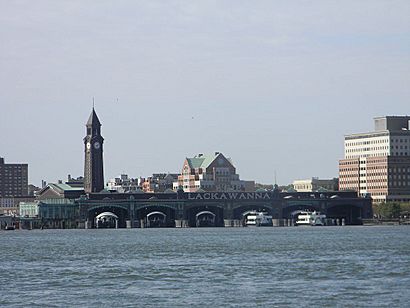
Hoboken Terminal from the Hudson River in 2012
|
|||||||||||||||||||||||||||||||||||||||||||||||||||
| Location | 1 Hudson Place Hoboken, New Jersey |
||||||||||||||||||||||||||||||||||||||||||||||||||
| Owned by | New Jersey Transit (street level) Port Authority of New York and New Jersey (underground) |
||||||||||||||||||||||||||||||||||||||||||||||||||
| Line(s) | Hoboken Division Uptown and Downtown Hudson Tubes |
||||||||||||||||||||||||||||||||||||||||||||||||||
| Platforms | 9 island platforms, 1 side platform | ||||||||||||||||||||||||||||||||||||||||||||||||||
| Tracks | 18 | ||||||||||||||||||||||||||||||||||||||||||||||||||
| Connections | |||||||||||||||||||||||||||||||||||||||||||||||||||
| Construction | |||||||||||||||||||||||||||||||||||||||||||||||||||
| Platform levels | 2 | ||||||||||||||||||||||||||||||||||||||||||||||||||
| Bicycle facilities | 88 spaces | ||||||||||||||||||||||||||||||||||||||||||||||||||
| Disabled access | Yes | ||||||||||||||||||||||||||||||||||||||||||||||||||
| Other information | |||||||||||||||||||||||||||||||||||||||||||||||||||
| Station code | HOB 20496, 20497 (NJT Bus) |
||||||||||||||||||||||||||||||||||||||||||||||||||
| Fare zone | 1 | ||||||||||||||||||||||||||||||||||||||||||||||||||
| History | |||||||||||||||||||||||||||||||||||||||||||||||||||
| Opened | February 25, 1907 | ||||||||||||||||||||||||||||||||||||||||||||||||||
| Electrified | September 3, 1930: 25 kV 60 Hz (commuter rail) 600 V (DC) third rail (PATH) 750 V DC Overhead lines (light rail) |
||||||||||||||||||||||||||||||||||||||||||||||||||
| Traffic | |||||||||||||||||||||||||||||||||||||||||||||||||||
| Passengers (2017) | 15,628 (average weekday) (NJT) | ||||||||||||||||||||||||||||||||||||||||||||||||||
| Passengers (2018) | 8,267,843 |
||||||||||||||||||||||||||||||||||||||||||||||||||
| Services | |||||||||||||||||||||||||||||||||||||||||||||||||||
|
|||||||||||||||||||||||||||||||||||||||||||||||||||
|
|||||||||||||||||||||||||||||||||||||||||||||||||||
|
Erie-Lackawanna Railroad Terminal at Hoboken
|
|||||||||||||||||||||||||||||||||||||||||||||||||||
| Location | On the Hudson River at the foot of Hudson Place, Hoboken, New Jersey | ||||||||||||||||||||||||||||||||||||||||||||||||||
| Area | 4 acres (2 ha) | ||||||||||||||||||||||||||||||||||||||||||||||||||
| Built | 1907 | ||||||||||||||||||||||||||||||||||||||||||||||||||
| Architect | Kenneth MacKenzie Murchison | ||||||||||||||||||||||||||||||||||||||||||||||||||
| Architectural style | American Industrial | ||||||||||||||||||||||||||||||||||||||||||||||||||
| NRHP reference No. | 73001102 | ||||||||||||||||||||||||||||||||||||||||||||||||||
| Added to NRHP | July 24, 1973 | ||||||||||||||||||||||||||||||||||||||||||||||||||
Hoboken Terminal is a really important transportation hub in Hoboken, New Jersey. It's like a giant meeting point where many different types of trains, buses, and ferries come together. More than 50,000 people use this terminal every day! This makes it one of the busiest train stations in North America. It's also a super important place for people traveling in the New York metropolitan area.
You can catch NJ Transit commuter trains, the PATH subway system, the Hudson–Bergen Light Rail, various buses, and even NY Waterway ferries to Manhattan from here. Hoboken Terminal is designed to be easy for everyone to use, including those in wheelchairs.
Contents
History of Hoboken Terminal
The area where Hoboken Terminal stands has been a busy spot for travel for a very long time. Even before cars and trains, people used this spot to link Manhattan Island with places to the west. It was a popular ferry landing, reached by old roads called turnpikes. In 1811, the first steam-powered ferries started running here, thanks to an inventor named John Stevens, who also founded Hoboken.
As railroads grew, more and more travelers came to the west side of the Hudson River. If you wanted to go to Manhattan from most of the United States, you had to switch to a ferry at the riverbank. Tunnels were built through Bergen Hill to connect the trains to the ferry terminals. The first tunnel opened in 1876.
The modern Hoboken Terminal was built in 1907 by the Delaware, Lackawanna, and Western Railroad (DL&W). They also opened a second tunnel in 1908. Both of these tunnels are still used by NJ Transit today. The PATH subway system, which was then called the Hudson and Manhattan Railroad, also extended its lines to Hoboken Terminal when it opened. The first PATH train left the terminal on February 26, 1908.
At one point, there were five major train terminals along the Hudson River waterfront, all run by different companies. Hoboken Terminal is the only one still in use today! The others were taken down in the 1960s.
In 1976, a company called Conrail took over the terminal. Then, in 1983, New Jersey Transit (NJ Transit) bought the terminal and other rail properties in northern New Jersey.
Long ago, many streetcar lines also started and ended at the station. These were replaced by buses by 1949.
Ferry service from the terminal to lower Manhattan stopped in 1967. But it started again in 1989 and moved back into the beautiful, restored ferry slips inside the historic terminal in 2011. The terminal's tall clock tower was also rebuilt between 2005 and 2009. The building's walls were even taken down and rebuilt to look just like they did when it first opened!
In October 2012, Hurricane Sandy caused a lot of damage to the station. Water rose as high as 5 feet inside the building and 8 feet in the PATH tunnels. The main waiting room reopened in January 2013, and train services were slowly brought back to normal by March 2013.
Cool Facts About Hoboken Terminal
In 1930, famous inventor Thomas Edison was there for the first trip of a regular electric train from Hoboken Terminal. This station also had one of the first public air-conditioning systems. Plus, it was one of the first places where mobile phones were used outside of experiments!
Because of its unique look, the station has been used in many movies and music videos. Some famous films shot here include Funny Girl, Three Days of the Condor, and Once Upon a Time in America.
Services at Hoboken Terminal
Hoboken Terminal is a very busy place with many ways to travel!
Commuter Rail
Hoboken Terminal is the main station for NJ Transit's Hoboken Division. This includes many train lines that serve northern New Jersey. Some of the lines you can catch here are:
- Main Line
- Bergen County Line
- Pascack Valley Line
- Morristown Line and Gladstone Branch
- Montclair-Boonton Line
- North Jersey Coast Line (limited service)
- Meadowlands Rail Line (for special events)
- Port Jervis Line
- Raritan Valley Line (one morning train on weekdays)
You can connect to other NJ Transit train lines at Newark Penn Station, Secaucus Junction, or Newark Broad Street.
PATH Subway System
|
Hoboken
|
|
|---|---|
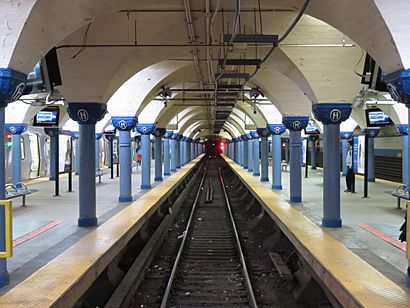
PATH station platforms
|
|
| Services | |
|
|
PATH trains run 24 hours a day from an underground station with three tracks. You can enter the PATH station from the main terminal or directly from the street. There are elevators and stairs to help you get down to the platforms.
Light Rail
|
Hoboken
|
|||||||||||||||||||
|---|---|---|---|---|---|---|---|---|---|---|---|---|---|---|---|---|---|---|---|
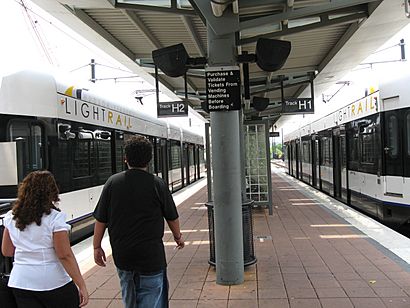
HBLR platform at tracks H1 and H2
|
|||||||||||||||||||
| Construction | |||||||||||||||||||
| Disabled access | Yes | ||||||||||||||||||
| Other information | |||||||||||||||||||
| Fare zone | 1 | ||||||||||||||||||
| Services | |||||||||||||||||||
|
|||||||||||||||||||
Hoboken Terminal is the end point for two of the three Hudson-Bergen Light Rail routes. The light rail platforms are located south of the main terminal building. You can also walk from here to 14th Street along the Hudson River.
Ferry Service
NY Waterway operates ferry service from Hoboken Terminal. You can take a ferry to places like Brookfield Place Terminal and Pier 11/Wall Street every day. On weekdays, you can also go to the West Midtown Ferry Terminal. The ferry area has five slips where boats dock.
Bus Service
Ten different bus routes operated by New Jersey Transit Bus Operations serve Hoboken Terminal. The buses leave from different lanes. For example, bus route 126 goes to the Port Authority Bus Terminal in Manhattan. Other routes go to various towns in New Jersey like Jersey City, East Rutherford, and Lakewood.
Past Long-Distance Trains
Before the 1960s, Hoboken Terminal was also a major station for long-distance trains. These trains would travel far beyond the daily commuter routes, going all the way to cities like Buffalo and Chicago. Some famous trains like the Phoebe Snow and the Erie Limited used to start their journeys from Hoboken Terminal.
Design and Landmark Status
The Hoboken Terminal buildings were designed by architect Kenneth M. Murchison in a beautiful style called Beaux-Arts. They were built in 1907. Today, the terminal is recognized as a historic place and is listed on both the New Jersey and National Registers of Historic Places.
The main waiting room is very large and is considered one of the most beautiful in the U.S. It has amazing stained glass designs by Louis Comfort Tiffany that show flowers and Greek patterns. The outside of the terminal is more than four stories tall and has a special copper covering with fancy details.
A tall, 225-foot clock tower was part of the original terminal. But it had to be taken down in the 1950s because it was damaged by weather. A new clock tower, which looks exactly like the original, was built during the terminal's 100th anniversary in 2007. This new tower has 4-foot-high copper letters that spell out "LACKAWANNA" and light up at night.
Hoboken Terminal is seen as a very important building in the history of transportation in America. It brought together trains, ferries, subways, streetcars (and later buses and light-rail) all in one place. It was also one of the first stations to use a special type of train shed called the Bush-type, which became very popular.
Around the Terminal and How to Get There
Even though the main passenger areas are in Hoboken, some of the train tracks and other parts of the system are actually in Jersey City. The border between Hoboken and Jersey City runs through the train yard.
It's a bit tricky to drive right up to the station. Buses can enter their special terminal area. Other cars have to turn onto Hudson Place, which is a short street right next to the station. This street is where you can get dropped off or picked up, and there's a special area for taxis. To leave the terminal by car, you have to drive north on River Street for at least one block.
Hudson Place leads to a square called Warrington Plaza. Here you'll find the main entrance to the waiting room. There's also a statue of Sam Sloan, who was the president of the DL&W railroad. The plaza is named after George Warrington, who helped save and buy the station for NJ Transit.
In 2009, it became easier for people to walk to the terminal from the south side. A new part of the Hudson River Waterfront Walkway opened, connecting to the terminal. This walkway lets you walk along the Hudson River for a long distance.
Images for kids
-
Ferry terminal in use between 1989 and 2011 for WFC-bound boats
- NJT rail station information page for Hoboken Terminal
- DepartureVision real time train information for Hoboken Terminal
- NJT Hudson–Bergen Light Rail station information page for Hoboken Terminal
- Historic American Engineering Record (HAER) No. NJ-59, "Delaware, Lackawanna and Western Railroad and Ferry Terminal, Ferry Slips and Bridges"
- HAER No. NJ-135-A, "Delaware, Lackawanna and Western Railroad Freight and Rail Yard, Long Slip Canal"
- HAER No. NJ-135-B, "Delaware, Lackawanna and Western Railroad Freight and Rail Yard, Multiple Unit Light Inspection Shed"
See also
 In Spanish: Terminal Hoboken para niños
In Spanish: Terminal Hoboken para niños


